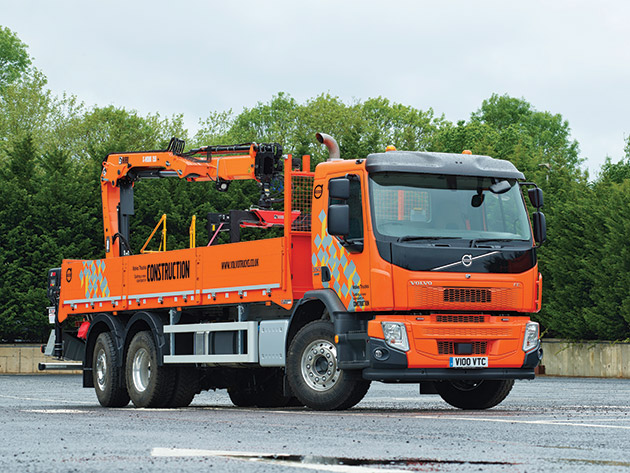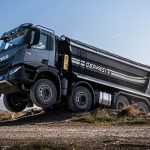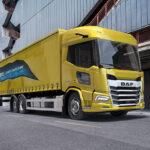
Last year Volvo Trucks added the 350hp engine and a new nine tonne front axle to the list of options for the FE, making the truck more versatile to meet the demands of local repetitive work. Kevin Swallow took to the Scottish Borders to see if the FE can deliver the goods in a tight terrain.
THE THREE axle rigid chassis cab is road transport’s most versatile asset. It operates in every sector from refuse, to construction, to home delivery and as a result, manufacturers like to make a virtue of how they are able to produce a wide ranging selection of vehicles to provide a viable option for everyone. So, there was little surprise when last year Volvo Trucks unveiled a new, more powerful rating for its 7.7 litre engine as a flagship for the FE range.
At the launch Anders Edenholm, Volvo’s segment manager for distribution, cemented that commitment to being everything to everyone. By broadening the FE’s reputation as a flexible and agile truck it would further ‘meet the demands of many customers,’ he said.
In particular the 350 option covers a lot of ground from a two axle 18 tonner through to the three axle 26 tonner Transport News was testing, right through to potential drawbar combinations up to 44 tonnes gross combination weights (GCW) using three axle drawbar trailers.
For this road test, Volvo has given the FE350 6×2 rear steer chassis a construction specification with a rear mounted Hiab XS158 crane that has a 5.0 tonne lifting capacity at 2.7 metres and 1.85 tonnes at 7.8 metres, all with a Lawrence David dropside body to carry bricks to wholesalers, retailers and building sites.
The arrival of the 350 means there are now four choices for the six cylinder 7.7 litre D8K engine. These are badged at 250hp/950Nm torque, 280hp/1,050Nm torque, 320hp/1,200Nm torque and 350hp/1,400Nm torque. The true power rating of the badged 350 is 346hp. To achieve Euro 6, the driveline uses a combination of exhaust gas recirculation (EGR) and selective catalytic reduction (SCR).
The green band is from 1,000rpm to 1,700rpm, while to get the best from the 120kW exhaust brake power you need to be at 2,800rpm. Transmission is the 12 speed I-Shift gearbox with the ‘fuel and economy’ software attached, as well as cruise control and EcoRoll.
You can order 4×2, 6×2 or 6×4 axle configurations or as a lightweight 4×2 tractor. For the 6×2 there are 13 wheelbase options from 3,500mm to 6,450mm. This particular truck had a 4,750mm wheelbase to the drive axle, with an extra 1,350mm to the rear steer.
Perhaps a more important weight issue is Volvo Trucks’ decision to launch a new 9.0 tonne front axle. Overloading the front axle is a real issue for the driver and operator with rigids, especially with a diminishing load, so anything that helps spread the load is welcomed.
The Day cab option, has 5.9cu.m internal space. Other options are the Comfort cab and Sleeper cab.
NEW TN ROUTE
To try and mimic a typical day behind the wheel of a construction spec vehicle Transport News has devised an exclusively ‘A road’ route through the Scottish Borders, Northumberland and Cumbria. It is designed to put the truck through its paces on undulating roads forcing the engine to go up and down the gearbox and use the engine brake rather than running at a constant speed seeking fuel economy.
To that end, the automated 12 speed transmission worked hard on the undulating A7 towards Selkirk and down the A68 and at times we held the gear, usually 10 or 11, using the manual override function on several drawn climbs to let it dig in. The 350hp is more than enough for 26 tonnes gross vehicle weight, but it’s also worth noting that even with this power at its disposal the climb up and over Carter Bar saw the truck drop to ninth for the tighter corners near the base before working back up to 11th gear at the crest. We’ll see how that stands up in future tests.
That 200Nm extra torque is arguably where this truck really comes into its own as it’s able to dig in and remain in higher gears for longer than the 320hp version and its 1,200Nm torque.
It has to be said, arriving at Carter Bar doing 40mph, and then leaving it doing 50mph, shows just how frustrating differing speed limits are for the driver, but also the traffic amassing behind.
Selecting the rear steer option means the truck is able to tackle the corners and bends in a much smoother fashion allowing the truck to retain momentum. Typically a non steer, load bearing rear axle invites friction as its turns sideways on a corner and that natural scrub slows the truck and reduces the service life of the tyres.
In Selkirk, where there are several tight turns with roadworks and scaffolding, the rear steer option also meant the truck took up less road space.
No driver really enjoys a day cab, let alone one labelled ‘short day cab’. Anyone with long legs automatically forces the seat to the back wall, which means there is nowhere to recline during a legal break. Most drivers merely slump over the steering wheel!
Volvo does what it can to minimise the claustrophobia with a comfortable suspended driver’s seat, adjustable shock absorber, lumbar support and heating. You’d be surprised just how often the heated seat is welcomed by drivers. There is a decent storage box on top of the engine tunnel, and a clothes rail on the rear wall for coats and hats. Controls for the rear mounted crane sit between the storage box and the dashboard.
NIGHT HEATER SUGGESTION
One area that manufacturers might want to consider is introducing a day cab version of the night heather. During winter months a driver will run the engine continuously to keep the cab warm, from an early start to taking a mandatory break, that only serves to increase the amount of time the engine is idling. A modified night heather might just be the answer.
In the bottom of the passenger door is a large auxiliary window, which Transport for London might well consider ineffective when it finally delivers the Direct Vision Standard later this year. If you travel with a passenger then it’s a pointless addition, and in a day cab most drivers use the passenger footwell as storage for bags and equipment further reducing the visibility. Plus the auxiliary window compromises the passenger window, which in the FE slides partially forward.
While the last two points are more generic and relative across all the manufacturers, the ergonomics of the interior is undoubtedly French with a Swedish twist. When the French launched its distribution range they worked hard to promote ergonomics and make the driver’s life easier. The angled dash and bank of controls to the left of the steering column means the driver can find a switch or rotary with a quick glance.
The test route gave Transport News a decent insight into the kind of environment in which a three axle truck usually works. Repetitive local journeys means the driver, and the operator, need something that can cope. The decision by Volvo to offer a more powerful version of the 7.7 litre engine is welcomed, but it’s the extra torque that comes in handy the most for the many hill climbs.
While payload is slightly reduced, some 40kg, selecting a Comfort cab might be a worthwhile consideration. The cab is 400mm longer and can be fitted with a fold up single bunk or be used as office/storage space. It makes life that much more tolerable for the driver and a 2kW night heater to warm up or retain cab heat when the vehicle is stationary would reduce the amount of engine idle, significantly improving the fuel bill.
Residual value alone would be enough to tick the 350 option; with all things being equal it should return a little more when defleeted. The real reason to select the 350 though is its performance. It’s got that little bit more oomph and the driver will welcome something that will comfortably deliver the goods.
CASE STUDY
Davey Forrest, the managing director of West Lothian based, Dechmont Forklift Trucks, bought his first Volvo FE from Volvo Truck and Bus Centre North & Scotland, Edinburgh.
It’s fitted with a 30ft plant body supplied by local company, Lothian Vehicle Bodybuilders (LVB), and powered by the Volvo’s D8K Euro 6 engine. He opted for the 320hp version with the I-Shift automated manual transmission and a Day cab.
‘Volvo Trucks has an established brand reputation for quality, safety and reliability,’ he said. ‘The location of the Edinburgh dealership of Volvo Truck and Bus Centre North & Scotland also proved attractive, as it’s only a few hundred yards from our own premises.’
The FE chassis, with a twin tyre tag axle, was selected for its weight capabilities. ‘Our largest CAT forklift truck model weighs in at 13.5 tonnes, which is well within the payload factor of our new Volvo FE. Smaller forklift truck moves across the whole of Scotland are the norm however and most days our driver can legally carry three forklifts.
‘After just a few weeks in operation, I already have a favourable opinion of the Volvo’s performance and the truck is doing exactly as Volvo said it would.’
The FE LVB beavertail body comes with an engineered sub-chassis that delivers a low bed height and a double hinged, heavy duty powered ramp provides a shallow approach angle for safe loading or unloading. A 6.8 tonne pull winch is also fitted immediately behind the day cab




